Cabbage Worms: Prevention, Control and Identification
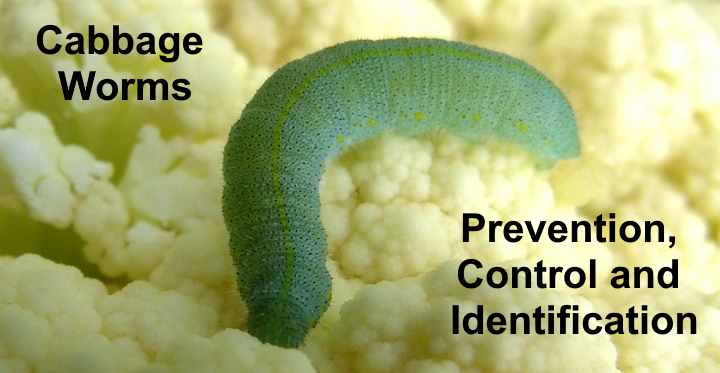
Cabbage worms are common pests in the garden if you grow kale, cabbages, broccoli, or other Brassica vegetables. Getting rid of cabbage worms fast is vital to protect your crops from the damage these green larvae cause. Cabbage worm eradication usually requires integrated pest control methods to prevent cabbage moths from laying eggs that hatch into leaf-destroying caterpillars.
This article is a comprehensive guide to preventing and getting rid of cabbage worms in your garden. You will also find out how to identify cabbage butterfly larvae to help spot them underneath cabbage, broccoli, kale, and Brussels sprout leaves.
What are Cabbage Worms?
Cabbage worms (Pieris rapae) are the green larvae of the cabbage butterfly. The cabbage butterflies—also called small white or cabbage white—lay eggs on brassica plants. After hatching, the green caterpillars feed on leaves until they pupate and turn into white butterflies.
Cabbage worms are also called the “imported cabbageworm” as it’s not native to North America.
Cabbage Worm (Pieris rapae) Identification
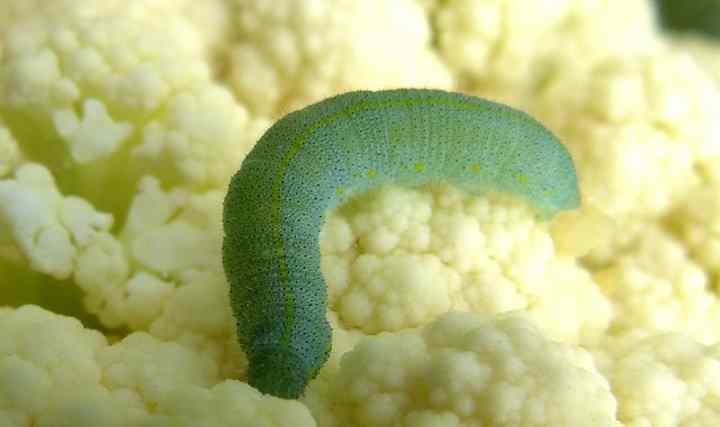
Cabbage worms (Pieris rapae)
Cabbage worms have a green, velvety appearance and measure up to 1.2” (3 cm) long. Cabbage worms also have a characteristic thin yellow stripe along the center of their back. You can spot the green worms on the underside of plants in the brassica genus.
If their numbers are significant, signs of cabbage worm damage can also help identify the green cabbage worm. For example, holes in mustard greens or cruciferous vegetables usually indicate that cabbage worms are active.
To help prevent a cabbage worm infestation, it’s also vital to recognize how to spot cabbage butterflies (sometimes called cabbage moths). The cabbage worm butterfly has creamy-white wings with black wingtips and two black spots in the center of the forewings. The white butterfly measures 1.3 – 1.9 (3.2 – 4.7 cm).
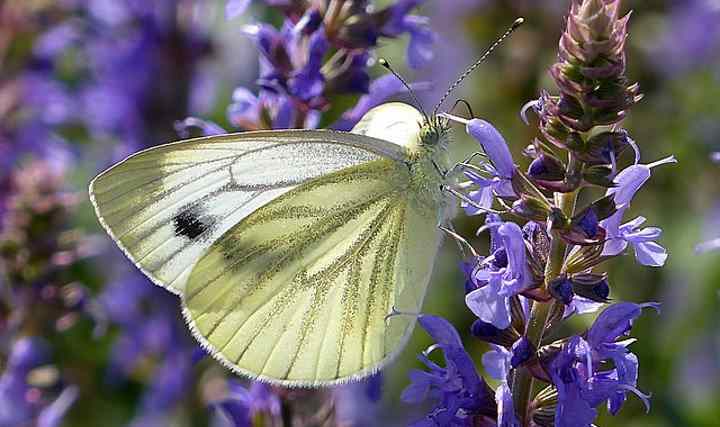
Cabbage butterfly
As soon as you spot white cabbage butterflies fluttering around plants during the day, it would be best if you looked for signs of cabbage worm eggs and larvae.
Cabbage worm vs. cabbage looper

Cabbage looper (Trichoplusia ni)
Cabbage worms are sometimes confused with cabbage loopers. Although both types of green caterpillars destroy cabbage plants, they are different species. Cabbage loopers (Trichoplusia ni) have an identifying characteristic of arching their bodies in a looping motion when they crawl on plants. In addition, cabbage loopers have a white stripe on their side.
Cabbage Worm Eggs
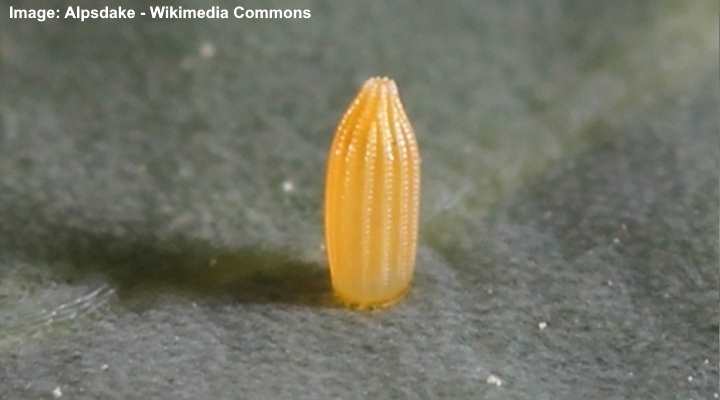
Close up image of a cabbage worm egg
Cabbage worm eggs look like small yellowish oblong dots – 1 mm long – with raised ridges along the length. The small white butterfly lays eggs in irregular patterns on the underside of leaves. Crushing the tiny yellow eggs is an excellent way to prevent a cabbage worm infestation.
The trait of laying cabbage worm eggs sporadically helps to identify them from ladybug eggs.
Cabbage Worm Life Cycle
The cabbage worm life cycle starts as a tiny yellowish-white egg. A female white cabbage butterfly lays up to 200 eggs on the undersides of leaves in the brassica family. After seven days, eggs hatch into tiny green caterpillars. The cabbage worms go through five stages, eventually becoming 1.2” (3 cm) long after 15 days.
Cabbage worms pupate in a chrysalis 0.8” (2 cm) long. The pupae have a mottled gray or green appearance with yellowish markings. During summer, the cabbage worm pupates for around 11 days. A cabbage worm that pupates in the fall usually overwinters in the pupa, and the cabbage butterfly emerges the following spring.
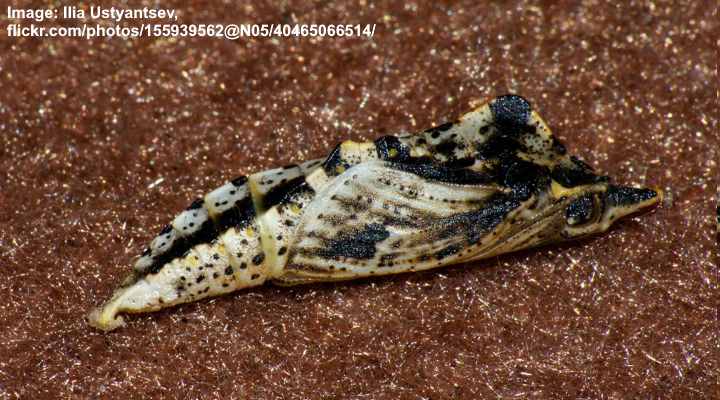
cabbage worm pupa
The complete life cycle of cabbage worms takes three to six weeks. Depending on the climate, there can be two or three to eight generations a year. Cabbage worms and small whites are active throughout the summer.
Cabbage Worm Damage
Cabbage worms are voracious eaters and quickly cause extensive damage to the host plant. Cabbage worms chew holes in cabbage plant leaves, and large larvae will also chew through stems. As the imported cabbageworms grow and numbers increase, large holes become more noticeable. In addition, severe cabbage worm infestations can skeletonize cabbage plant foliage.
In large cabbage worm infestations, the green larvae also burrow into broccoli and cabbage heads. There the worms leave behind fecal matter that looks like tiny dark green pellets. Cabbage worm poop can also discolor and contaminate vegetable leaves.
If left unchecked, cabbage worm damage can result in lower yields or completely destroy crops.
How to Get Rid of Cabbage Worms in Your Garden?
Getting rid of cabbage worms requires a multi-method control and prevention strategy. Checking cabbage plants for eggs, hand removing green cabbage worms and loopers, and using natural insecticide sprays are helpful. In addition, beneficial insects that prey on larvae can help to control cabbage worm numbers.
Let’s look in more detail at various effective methods of eradicating cabbage worms from your garden.
Get Rid of Cabbage Worms Manually
Handpicking green worms from cabbage plants is an effective eradication method. However, you should also carefully inspect the undersides of leaves for tiny yellow cabbage worm eggs. You can kill the crawling green worms by dropping them in soapy water. To kill the eggs, squeeze them with your fingers.
Once or twice a week, inspect your cabbage, broccoli, bok choy, kale, cauliflower, and other brassica vegetable leaves. Look for small green worms that are crawling or moving in a looping action. Then just pick the caterpillar from the leaves, and drown them in soapy water to kill them for good.
Because cabbage worms and loopers have a similar color to the leafy green foliage, you will have to look hard for them.
Remember that the small whites are active throughout the year, laying eggs. So be on the lookout for whitish or yellowish dots stuck to the undersides of leaves. If you feel squeamish, you can wipe the leaves clean with a damp cloth to remove the eggs before they hatch and damage.
Beneficial Insects to Control Cabbage Worms Naturally
Beneficial insects that prey on cabbage worms can help in your battle against these plant-destroying pests. Several species of bugs, beetles, spiders, wasps, parasitoid flies, and birds attack the green worms before pupating. Therefore, this method of cabbage worm control is helpful in conjunction with other eradication strategies.
Here are a few ways that beneficial insects help to control cabbage worms without pesticides:
Parasitic wasps lay eggs on or inside cabbage worm larvae and their pupae. As the wasp larvae hatch, they start feeding on the green worms, killing them before they can do more damage to plants. In addition, Trichogramma wasps feed on cabbage worm eggs and prevent them from hatching.
Vespid wasps also attack the wriggling green worms and feed on them.
To attract beneficial insects, it’s vital to avoid using pesticides or insecticides. Although chemicals will kill loopers and cabbage worms reasonably quickly, they will also kill beneficial insects. Additionally, harmful garden pests can build up resistance to pesticides, making them less effective over time.
It is good to remember that a few holes in cabbage leaves aren’t anything to worry about. As long as you keep cabbage worms under control, they shouldn’t cause too much damage to your vegetables.
Bacillus Thuringiensis (Bt) to Get Rid of Cabbage Worms Organically
Bt is effective for killing cabbage worms without using harmful insecticides. A Bacillus thuringiensis (Bt) spray can help kill immature larvae. You should apply the Bt spray every seven days in the evening, ensuring that all parts of the plant are covered.
Bacillus thuringiensis is a naturally occurring soil bacteria that is poisonous on butterfly and moth larvae. However, Bt is not toxic to humans or pets and doesn’t contaminate the food chain. You can buy the cabbage worm spray in pre-mixed formulas or concentrate that you dilute with water.
A study on controlling cabbage worms using organic methods found that Bt is effective for Pieris rapae. However, scientists found that Bt was even more effective for controlling cabbage worms when used together with parasitic wasps Trichogramma brassicae. Therefore, the study concluded that the “best treatment for control of Pieris rapae in organic cabbage to be Bt+Trichogramma.”
When using Bt for cabbage worms, it’s best to apply the solution in the evening. This ensures that the sunlight doesn’t affect the effectiveness of the organic control method.
Neem Oil to Eradicate Cabbage Worms
A neem oil spray can help to kill cabbage worm larvae before they cause too much damage. Make a neem oil solution by mixing 2 tsp. organic neem oil, 1 tsp. Castile soap, and a quart (1 l) of water in a spray bottle. Apply the neem oil spray once a week to kill cabbage worms.
Neem oil is a natural substance that comes from the neem tree and contains the active ingredient azadirachtin, which is a natural pesticide. Neem oil is effective on cabbage worms because it affects their life cycle by interfering with feeding and reproduction. You can also use neem oil to control other types of garden and houseplant pests.
A study into the effectiveness of neem oil as a natural insecticide found it effective in controlling cabbage worms. A neem oil spray helped inhibit Pieris rapae larvae growth in several instars, including mature caterpillars. Also, cabbage larvae treated with neem oil died after pupation.
Neem oil is only helpful in killing cabbage worms when used with other pest control methods. Therefore, it’s vital to continue checking brassica plants regularly for cabbage loopers and worms, as well as their eggs.
Spinosad Spray to Kill Cabbage Worms
Spinosad spray is a harmless, non-toxic method of killing cabbage worms if you use organic farming techniques. Spinosad is a natural bacteria that kills off insects in their larval stage. Usually, Spinosad products are ready to use for spraying on caterpillars and insect eggs before they hatch.
It’s good to remember that Spinosad sprays can affect beneficial insects. Therefore, it’s best to avoid using the spray when pollinators are active.
Cabbage Worm Control
To get rid of cabbage worms from your cruciferous and brassica plants, it’s vital to prevent small whites from laying eggs on cabbage plants. Additionally, it is a good idea to plant cabbages, broccoli, kale, and other cruciferous vegetables resistant to cabbage worms.
Use Row Covers to Prevent Cabbage Worms
Covering your plants is one of the best ways to prevent cabbage worms from destroying your crops. Floating row covers stop cabbage whites from laying eggs on plants. In addition, the covers form a protective barrier against butterflies and other bugs that can eat plant foliage.
With other vegetables, row covers have the disadvantage of not allowing pollinators in. However, plants in the family Brassicaceae don’t need pollination to grow their leafy greens. So, you can protect immature cabbage plants with paper cups in the early season. Then when the kale, broccoli, cabbage, and Brussels sprouts grow larger, you can place floating row covers over them.
Companion Planting to Deter Cabbage Worms
Planting techniques can help to prevent cabbage worms from devastating your crops. For example, you could try polyculture by growing various plant types in one vegetable patch or raised bed. Or, companion planting plants that deter cabbage worm butterflies can help prevent the larvae from infesting your plants.
With polyculture, you can mix up your vegetable patch to have a variety of vegetables growing together. For example, rather than only having cabbage or broccoli, you could have a mixture of root vegetables, bulbous plants, and leafy greens. This type of planting is a natural pest management strategy and helps to reduce plant diseases.
Some types of plants are said to repel adult cabbage worm butterflies. Therefore, along with brassica plants, you could plant onions, garlic, oregano, dill, and marigolds to prevent many adult butterflies from laying eggs on plants.
Plant Resistant Cabbage Varieties
Plant varieties of cabbage and brassica plants that are more resistant to cabbage worms. Some types of cabbages are relatively resistant to imported cabbageworms. Additionally, brassica plants with dark green, purple, or glossy leaves tend to repel cabbage butterflies. The dark pigments in some cabbage plants are distasteful to many larvae, and they tend to avoid feeding on them.
According to the University of Florida, cabbage worms prefer collards, cabbage, broccoli, and cauliflowers. However, they usually avoid brassica vegetables such as turnips, Chinese cabbage, kale, and mustard greens.
Related articles:
